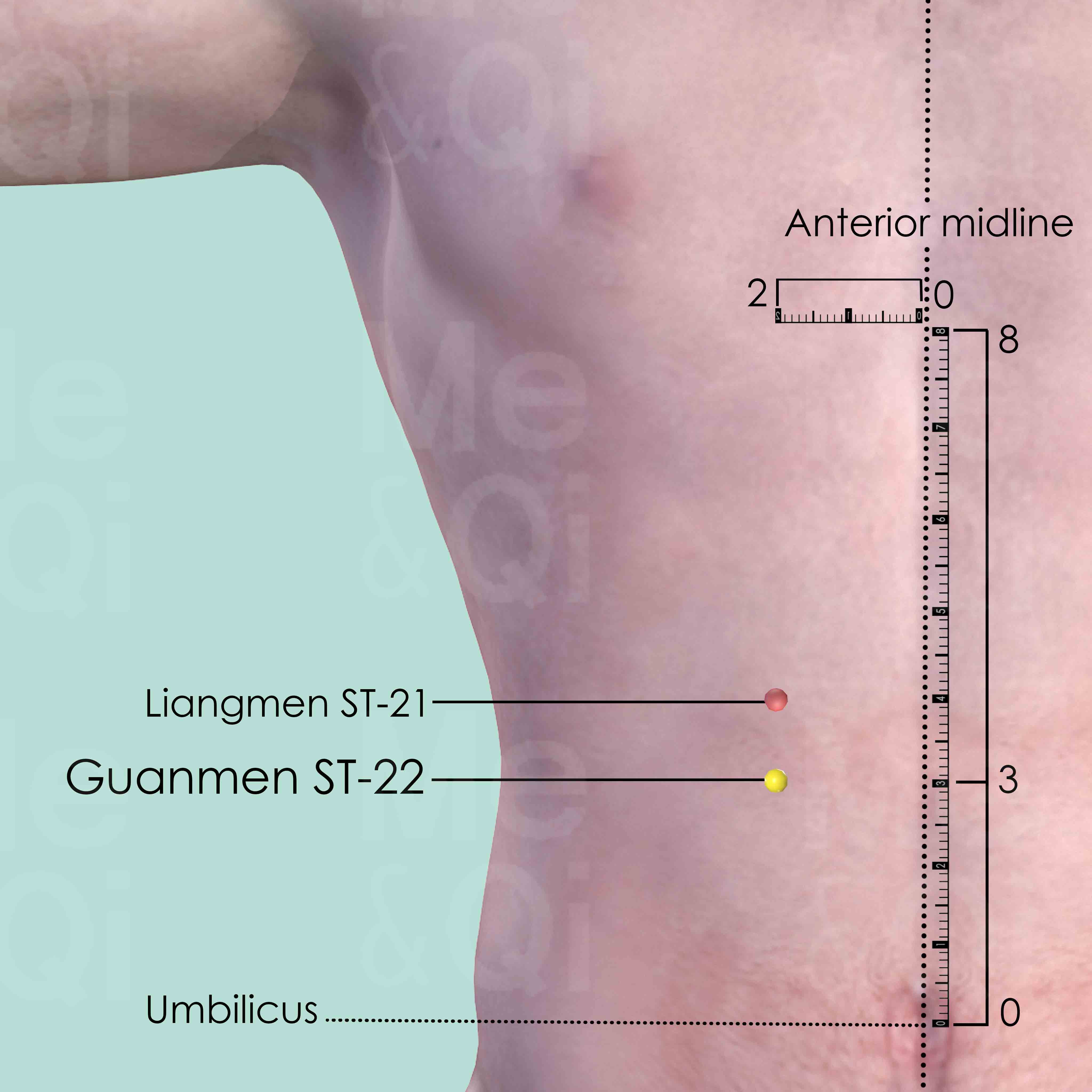Upper Abdominal Fullnessaccording to TCM
Symptom families: Upper Abdominal Pain and Discomfort, Abdominal Distension and Fullness
Parent symptom: Abdominal Fullness
Did you mean? Upper Abdominal Pain Upper Abdominal Oppression
What is Upper Abdominal Fullness?
Upper abdominal fullness is a symptom characterized by a sensation of tightness, swelling, or an uncomfortable pressure in the area above the navel and below the chest. This sensation can be persistent or intermittent, often worsening after eating or during periods of stress. It is associated with a range of digestive discomforts, including bloating and a feeling of being overly full regardless of the amount of food consumed.
How Does TCM View Upper Abdominal Fullness?
Traditional Chinese Medicine (TCM) interprets upper abdominal fullness as a manifestation of disharmony within the body’s energy system, particularly involving the Spleen and Stomach. TCM emphasizes the flow of Qi (vital energy) and balance among the body's organ systems.
It suggests that upper abdominal fullness can result from imbalances such as Dampness, Heat, or Stagnation affecting these organs, impacting the smooth flow of Qi and Body Fluids through the body.
Root Causes of Upper Abdominal Fullness in TCM
TCM attributes upper abdominal fullness to several patterns of disharmony, primarily focusing on the Spleen and Stomach's functional disturbances. A common pattern involves the invasion of Damp-Heat, where the body accumulates excessive moisture combined with Heat, leading to symptoms such as a feeling of heaviness, lack of appetite, and nausea.
Another prevalent pattern is the Cold-Damp invasion, where Cold and Damp qualities impede the Spleen's function, manifesting as epigastric discomfort, a sweet taste in the mouth, and a general sensation of heaviness. These patterns reflect an imbalance in the body's energy system, affecting the flow of Qi and the balance of Yin and Yang, ultimately leading to the symptom of upper abdominal fullness.
Explore below more details about what might cause Upper abdominal fullness according to TCM.
- By Syndrome
- By Organ
- Heat
- Dampness
- Qi Stagnation
- Cold
- View More Causes
- Spleen
- Gallbladder
- Stomach
- Liver
- View More Organs
Heat
In TCM "Heat" signifies an excess of Yang energy, leading to an imbalance where heat predominates over the body's cool Yin aspects. This condition is metaphorically akin to an internal over-heating. Symptoms indicative of Heat can include feelings of warmth, fever, sweating, irritability, red face, thirst with a preference for cold drinks, and a rapid pulse. The tongue may appear red with a yellow coating. Unlike the common interpretation of heat in terms of temperature, in TCM, it represents a state of hyperactivity or inflammation in the body.... see more
Heat Patterns That Can Lead to Upper Abdominal Fullness
Common Symptoms: Nausea Feeling Of Heaviness Dry Mouth Without Desire To Drink Bitter Taste In The Mouth Lack Of Appetite Feeling Hot Dull Yellow Complexion Upper Abdominal Pain
| Pattern Name | Relevant Symptoms | Relevant Formulas |
|---|---|---|
| Damp-Heat invading the Spleen | Abdominal and epigastric fullness, Lack of appetite, Feeling of heaviness, Dry mouth without desire to drink, Nausea or vomiting, Malodorous diarrhea, Anal burning, Feeling hot, Scanty and dark urine, Low grade fever, Dull headache, Dull yellow complexion, Yellow sclera, Oily sweat, Itchy rashes, Bitter taste in the mouth, Upper abdominal fullness, Upper abdominal pain... see more | Lian Po Yin |
| Damp-Heat in the Stomach | Epigastrium fullness, Upper abdominal pain, Upper abdominal fullness, Feeling of heaviness, Face pain, Congested nose, Thick nasal discharge, Dry mouth without desire to drink, Nausea, Feeling hot, Dull yellow complexion, Sticky taste in the mouth... see more | Lian Po Yin | Ge Hua Jie Cheng San |
| Gallbladder Heat | Epigastrium fullness, Alternating sensation of hot and cold, Bitter taste in the mouth, Thirst, Dry throat, Hypochondriac pain, Nausea, Upper abdominal fullness... see more | Hao Qin Qing Dan Tang |
| Obstruction Of the Spleen By Dampness with Liver Qi Stagnation | Feeling of oppression and fullness of the epigastrium, Upper abdominal oppression, Nausea, Lack of appetite, Diarrhea, Feeling of heaviness, Dry mouth without desire to drink, Dull shallow face, Irritability, Upper abdominal distension, Hypochondriac distention, Hypochondriac pain... see more | Ping Wei San | Dang Gui Shao Yao San |
| Heat in Gall Bladder | Epigastrium fullness, Mild chills with high fever, Bitter taste in the mouth, Stifling sensation in the chest, Vomiting of sour fluids, Thirst, Hypochondriac pain and discomfort, Nausea, Upper abdominal fullness, Cholecystitis, Icteric hepatitis... see more | Hao Qin Qing Dan Tang |
Dampness
"Dampness" in TCM is a concept that describes a pattern of disharmony where the body accumulates excess moisture. Imagine the heavy, sticky feeling you get on a very humid day; that's similar to what dampness feels like internally. It can manifest as a sense of heaviness, bloating, sluggishness, or even a foggy mind. This condition is often thought to arise from environmental factors like living in a damp place, dietary habits that promote moisture in the body, or internal imbalances that hinder the body's ability to process fluids properly. In TCM, dampness can obstruct the normal flow of energy and fluids in the body, leading to various symptoms.... see more
Dampness Patterns That Can Lead to Upper Abdominal Fullness
Common Symptoms: Lack Of Appetite Nausea Feeling Of Heaviness Dry Mouth Without Desire To Drink Diarrhea Feeling Hot Dull Yellow Complexion Upper Abdominal Pain
| Pattern Name | Relevant Symptoms | Relevant Formulas |
|---|---|---|
| Cold-Damp invading the Spleen | Abdominal and epigastric fullness, Lack of appetite, Epigastric coldness, Head and body heaviness, Sweet taste in mouth, Absence of thirst, Diarrhea, General weakness, Generalized fatigue, Nausea, Edema, Dull pale complexion, White vaginal discharge, Upper abdominal fullness... see more | Ping Wei San |
| Damp-Heat invading the Spleen | Abdominal and epigastric fullness, Lack of appetite, Feeling of heaviness, Dry mouth without desire to drink, Nausea or vomiting, Malodorous diarrhea, Anal burning, Feeling hot, Scanty and dark urine, Low grade fever, Dull headache, Dull yellow complexion, Yellow sclera, Oily sweat, Itchy rashes, Bitter taste in the mouth, Upper abdominal fullness, Upper abdominal pain... see more | Lian Po Yin |
| Damp-Heat in the Stomach | Epigastrium fullness, Upper abdominal pain, Upper abdominal fullness, Feeling of heaviness, Face pain, Congested nose, Thick nasal discharge, Dry mouth without desire to drink, Nausea, Feeling hot, Dull yellow complexion, Sticky taste in the mouth... see more | Lian Po Yin | Ge Hua Jie Cheng San |
| Obstruction Of the Spleen By Dampness with Liver Qi Stagnation | Feeling of oppression and fullness of the epigastrium, Upper abdominal oppression, Nausea, Lack of appetite, Diarrhea, Feeling of heaviness, Dry mouth without desire to drink, Dull shallow face, Irritability, Upper abdominal distension, Hypochondriac distention, Hypochondriac pain... see more | Ping Wei San | Dang Gui Shao Yao San |
Qi Stagnation
Qi Stagnation in TCM is like having a traffic jam in your body's energy system. Qi, the vital life force that flows through your body, is supposed to move smoothly to maintain health and balance. But with Qi Stagnation, this flow gets blocked or slowed down, like cars stuck on a highway. This can lead to symptoms like feeling stressed, emotional mood swings, and physical discomfort, often described as a feeling of fullness or tightness, especially in the chest or abdomen. It's as though the body's internal energy circulation is disrupted, causing various issues. TCM sees this as an energy flow problem, different from modern medicine's focus on specific physiological processes.... see more
Qi Stagnation Patterns That Can Lead to Upper Abdominal Fullness
| Pattern Name | Relevant Symptoms | Relevant Formulas |
|---|---|---|
| Obstruction Of the Spleen By Dampness with Liver Qi Stagnation | Feeling of oppression and fullness of the epigastrium, Upper abdominal oppression, Nausea, Lack of appetite, Diarrhea, Feeling of heaviness, Dry mouth without desire to drink, Dull shallow face, Irritability, Upper abdominal distension, Hypochondriac distention, Hypochondriac pain... see more | Ping Wei San | Dang Gui Shao Yao San |
Cold
In TCM "Cold" as a pattern of disharmony refers to a specific type of imbalance within the body's systems, often linked to a deficiency or weakness. It's not about feeling physically cold or having a common cold, but rather a metaphorical description of certain symptoms and underlying conditions. When a TCM practitioner says someone suffers from "Cold," it usually implies that the body's Yang energy, which is warm and active, is insufficient or overpowered by Yin energy, which is cool and passive. Symptoms of Cold in TCM can include a general feeling of coldness, cold limbs, pale complexion, low energy, slow metabolism, and a preference for warmth. ... see more
Cold Patterns That Can Lead to Upper Abdominal Fullness
| Pattern Name | Relevant Symptoms | Relevant Formulas |
|---|---|---|
| Cold-Damp invading the Spleen | Abdominal and epigastric fullness, Lack of appetite, Epigastric coldness, Head and body heaviness, Sweet taste in mouth, Absence of thirst, Diarrhea, General weakness, Generalized fatigue, Nausea, Edema, Dull pale complexion, White vaginal discharge, Upper abdominal fullness... see more | Ping Wei San |
Spleen
In TCM the Spleen plays a vital role in digestion and transformation, converting food into energy and nutrients, and overseeing the distribution of Qi and Blood. It's also crucial in maintaining the health of muscles and limbs and ensuring the blood remains within the vessels. When the Spleen malfunctions in TCM, it can lead to a variety of issues such as digestive disorders, fatigue, weak muscles, bloating, and a feeling of heaviness. It can also cause a pale complexion, poor appetite, and a tendency to bruise easily. Emotionally, a Spleen imbalance is often associated with excessive worry or overthinking, reflecting its role in the interplay between physical and mental health.... see more
Spleen Patterns That Can Lead to Upper Abdominal Fullness
Common Symptoms: Lack Of Appetite Diarrhea Nausea Feeling Of Heaviness Dry Mouth Without Desire To Drink Epigastric Coldness Head And Body Heaviness Sweet Taste In Mouth
| Pattern Name | Relevant Symptoms | Relevant Formulas |
|---|---|---|
| Cold-Damp invading the Spleen | Abdominal and epigastric fullness, Lack of appetite, Epigastric coldness, Head and body heaviness, Sweet taste in mouth, Absence of thirst, Diarrhea, General weakness, Generalized fatigue, Nausea, Edema, Dull pale complexion, White vaginal discharge, Upper abdominal fullness... see more | Ping Wei San |
| Damp-Heat invading the Spleen | Abdominal and epigastric fullness, Lack of appetite, Feeling of heaviness, Dry mouth without desire to drink, Nausea or vomiting, Malodorous diarrhea, Anal burning, Feeling hot, Scanty and dark urine, Low grade fever, Dull headache, Dull yellow complexion, Yellow sclera, Oily sweat, Itchy rashes, Bitter taste in the mouth, Upper abdominal fullness, Upper abdominal pain... see more | Lian Po Yin |
| Obstruction Of the Spleen By Dampness with Liver Qi Stagnation | Feeling of oppression and fullness of the epigastrium, Upper abdominal oppression, Nausea, Lack of appetite, Diarrhea, Feeling of heaviness, Dry mouth without desire to drink, Dull shallow face, Irritability, Upper abdominal distension, Hypochondriac distention, Hypochondriac pain... see more | Ping Wei San | Dang Gui Shao Yao San |
Gallbladder
In TCM the Gallbladder has a unique role in storing and excreting bile, but more importantly, it's seen as crucial for decision-making and courage. It's closely connected to the Liver, assisting in the smooth flow of Qi (vital energy) and supporting the Liver's role in maintaining emotional balance. When the Gallbladder malfunctions or is imbalanced in TCM, it can lead to physical symptoms like gallstones, jaundice, or a bitter taste in the mouth. There might also be digestive disturbances, particularly related to fat metabolism. On an emotional level, a Gallbladder disorder can manifest as indecisiveness, timidity, or a tendency to easily succumb to stress. These symptoms highlight the TCM view of the Gallbladder as integral to both physical processes and emotional resilience.... see more
Gallbladder Patterns That Can Lead to Upper Abdominal Fullness
Common Symptoms: Bitter Taste In The Mouth Thirst Nausea Alternating Sensation Of Hot And Cold Dry Throat Hypochondriac Pain Mild Chills With High Fever Stifling Sensation In The Chest
| Pattern Name | Relevant Symptoms | Relevant Formulas |
|---|---|---|
| Gallbladder Heat | Epigastrium fullness, Alternating sensation of hot and cold, Bitter taste in the mouth, Thirst, Dry throat, Hypochondriac pain, Nausea, Upper abdominal fullness... see more | Hao Qin Qing Dan Tang |
| Heat in Gall Bladder | Epigastrium fullness, Mild chills with high fever, Bitter taste in the mouth, Stifling sensation in the chest, Vomiting of sour fluids, Thirst, Hypochondriac pain and discomfort, Nausea, Upper abdominal fullness, Cholecystitis, Icteric hepatitis... see more | Hao Qin Qing Dan Tang |
Stomach
In TCM the Stomach is regarded as the "sea of nourishment," pivotal for digesting food and transforming it into Qi and blood. It works closely with the Spleen to distribute these essential nutrients throughout the body. When the Stomach is out of balance or malfunctions in TCM, it often leads to digestive problems such as bloating, nausea, vomiting, poor appetite, or a feeling of fullness. There may also be issues like acid reflux or a sour taste in the mouth. Emotionally, an imbalanced Stomach can contribute to excessive worry and overthinking, reflecting the TCM belief that physical and emotional well-being are deeply interconnected.... see more
Stomach Patterns That Can Lead to Upper Abdominal Fullness
| Pattern Name | Relevant Symptoms | Relevant Formulas |
|---|---|---|
| Damp-Heat in the Stomach | Epigastrium fullness, Upper abdominal pain, Upper abdominal fullness, Feeling of heaviness, Face pain, Congested nose, Thick nasal discharge, Dry mouth without desire to drink, Nausea, Feeling hot, Dull yellow complexion, Sticky taste in the mouth... see more | Lian Po Yin | Ge Hua Jie Cheng San |
Liver
In TCM the Liver is viewed as the organ responsible for the smooth flow of Qi, Blood, and emotions throughout the body. It plays a key role in regulating mood, storing blood, supporting digestion, and ensuring the health of tendons and eyes. When the Liver malfunctions or is imbalanced in TCM, it can lead to a range of issues such as irritability, mood swings, menstrual irregularities, eye problems, and muscular stiffness or pain. A malfunctioning Liver in TCM reflects not only physical disturbances but also emotional and mental disharmony, emphasizing the holistic approach of TCM in addressing health and wellness.... see more
Liver Patterns That Can Lead to Upper Abdominal Fullness
| Pattern Name | Relevant Symptoms | Relevant Formulas |
|---|---|---|
| Obstruction Of the Spleen By Dampness with Liver Qi Stagnation | Feeling of oppression and fullness of the epigastrium, Upper abdominal oppression, Nausea, Lack of appetite, Diarrhea, Feeling of heaviness, Dry mouth without desire to drink, Dull shallow face, Irritability, Upper abdominal distension, Hypochondriac distention, Hypochondriac pain... see more | Ping Wei San | Dang Gui Shao Yao San |
TCM Herbal Formulas for Upper Abdominal Fullness
In Traditional Chinese Medicine (TCM), upper abdominal fullness is treated with specific herbs and formulas tailored to the underlying patterns of disharmony. For Damp-Heat conditions, practitioners might use formulas containing Huang Lian (Goldthread Rhizomes) to clear Heat and dry Dampness.
In cases of Cold-Damp affecting the Spleen, Atractylodes Rhizomes (Cang Zhu) are employed for their Spleen-strengthening and Damp-transforming qualities. Formulas like Ping Wei San are recommended to harmonize the Stomach, improve digestion, and relieve bloating. TCM emphasizes personalized treatment, combining herbal therapy with acupuncture to regulate Qi flow and address the root causes, ensuring not just symptomatic relief but also long-term balance and health.
Explore below some TCM herbal formulas used to address upper abdominal fullness, organized by cause and by formula type.
- By Cause
- By Formula Type
- Heat
- Dampness
- Qi Stagnation
- Cold
- View More Causes
- Formulas that transform dampness and harmonize stomach
- Formulas that clear heat and expel dampness
- Formulas that reduce food stagnation with tonification
- Formulas that harmonize lesser yang-warp disorders
- Formulas that invigorate blood and dispel blood stagnation
Top Formula for Heat:
Lian Po Yin
Suitable for Heat patterns that may cause upper abdominal fullness, such as Damp-Heat invading the Spleen or Damp-Heat in the Stomach
Learn moreAll Formulas Recommended for Upper Abdominal Fullness Caused by Heat
| Formula | Patterns Suitable For |
|---|---|
| Lian Po Yin | Damp-Heat invading the Spleen, Damp-Heat in the Stomach |
| Hao Qin Qing Dan Tang | Gallbladder Heat, Heat in Gall Bladder |
| Ping Wei San | Obstruction Of the Spleen By Dampness with Liver Qi Stagnation |
| Ge Hua Jie Cheng San | Damp-Heat in the Stomach |
| Dang Gui Shao Yao San | Obstruction Of the Spleen By Dampness with Liver Qi Stagnation |
Top Formula for Dampness:
Ping Wei San
Suitable for Dampness patterns that may cause upper abdominal fullness, such as Cold-Damp invading the Spleen or Obstruction Of the Spleen By Dampness with Liver Qi Stagnation
Learn moreAll Formulas Recommended for Upper Abdominal Fullness Caused by Dampness
| Formula | Patterns Suitable For |
|---|---|
| Ping Wei San | Cold-Damp invading the Spleen, Obstruction Of the Spleen By Dampness with Liver Qi Stagnation... see more |
| Lian Po Yin | Damp-Heat invading the Spleen, Damp-Heat in the Stomach |
| Ge Hua Jie Cheng San | Damp-Heat in the Stomach |
| Dang Gui Shao Yao San | Obstruction Of the Spleen By Dampness with Liver Qi Stagnation |
Top Formula for Qi Stagnation:
Ping Wei San
Suitable for Qi Stagnation patterns that may cause upper abdominal fullness, such as Obstruction Of the Spleen By Dampness with Liver Qi Stagnation
Learn moreAll Formulas Recommended for Upper Abdominal Fullness Caused by Qi Stagnation
| Formula | Patterns Suitable For |
|---|---|
| Ping Wei San | Obstruction Of the Spleen By Dampness with Liver Qi Stagnation |
| Dang Gui Shao Yao San | Obstruction Of the Spleen By Dampness with Liver Qi Stagnation |
Top Formula for Cold:
Ping Wei San
Suitable for Cold patterns that may cause upper abdominal fullness, such as Cold-Damp invading the Spleen
Learn moreFormulas that transform Dampness and harmonize Stomach
These formulas are suitable for some upper abdominal fullness-causing patterns like Cold-Damp invading the Spleen or Obstruction Of the Spleen By Dampness with Liver Qi Stagnation.
One such formula is Ping Wei San, with black atractylodes rhizome as a key herb.
Formulas that clear Heat and expel dampness
These formulas are suitable for some upper abdominal fullness-causing patterns like Damp-Heat invading the Spleen or Damp-Heat in the Stomach.
One such formula is Lian Po Yin, with goldthread rhizome as a key herb.
Formulas that harmonize lesser Yang-warp disorders
These formulas are suitable for some upper abdominal fullness-causing patterns like Gallbladder Heat or Heat in Gall Bladder.
One such formula is Hao Qin Qing Dan Tang, with sweet wormwood herb as a key herb.
Formulas that reduce food Stagnation with tonification
These formulas are suitable for some upper abdominal fullness-causing patterns like Damp-Heat in the Stomach.
One such formula is Ge Hua Jie Cheng San, with kudzu flower as a key herb.
Formulas that invigorate Blood and dispel Blood Stagnation
These formulas are suitable for some upper abdominal fullness-causing patterns like Obstruction Of the Spleen By Dampness with Liver Qi Stagnation.
One such formula is Dang Gui Shao Yao San, with white peony root as a key herb.
Acupoints for Upper Abdominal Fullness
Explore below some acupoints used to address upper abdominal fullness, organized by meridian.
- By Meridian
- Stomach Channel
- Directing Vessel
- Spleen Channel
- Bladder Channel
- Kidney Channel
- Governing Vessel
- Liver Channel
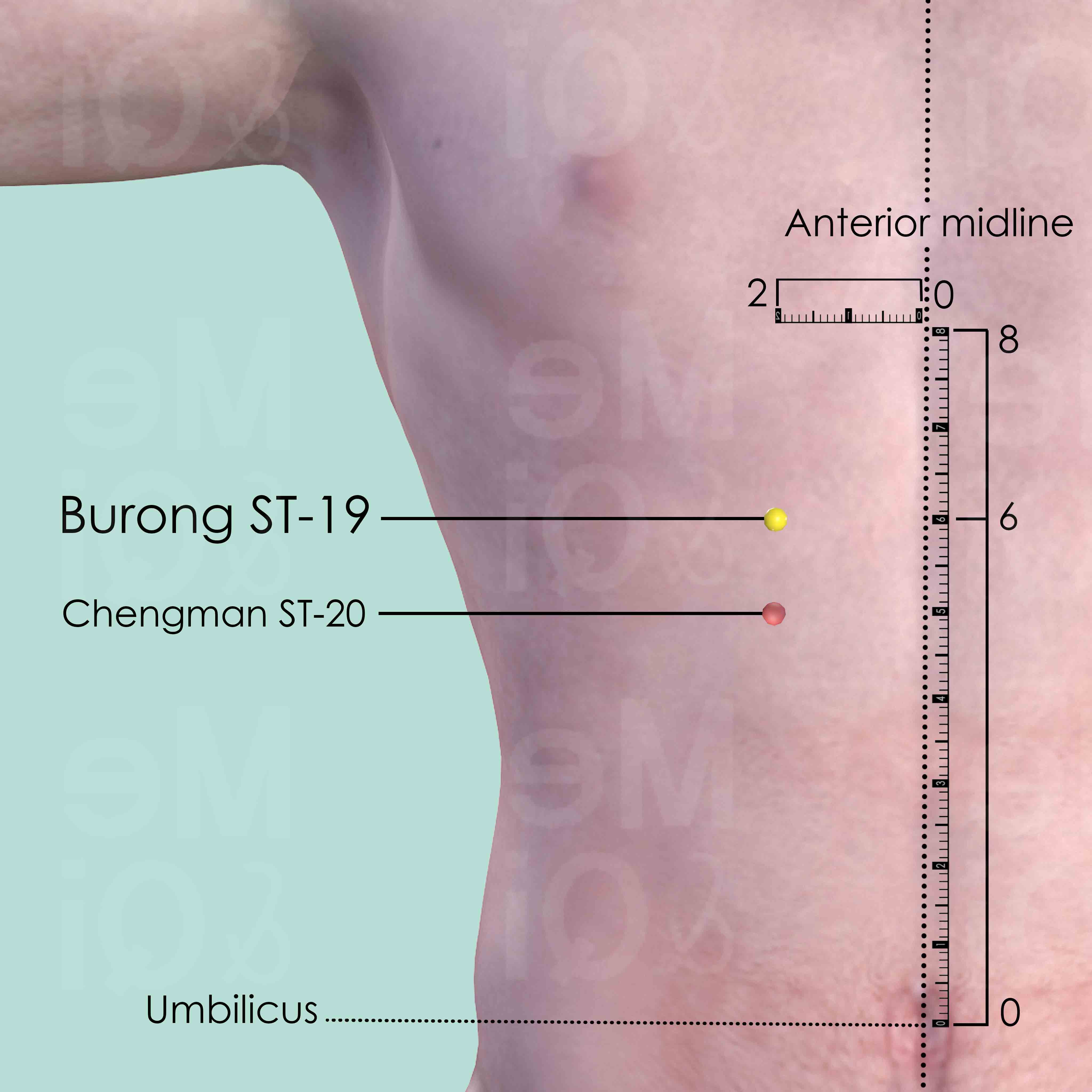
Burong ST-19
2 cun below the sternocostal angel and 6 cun above the umbilicus, 2 cun lateral to the anterior midline.
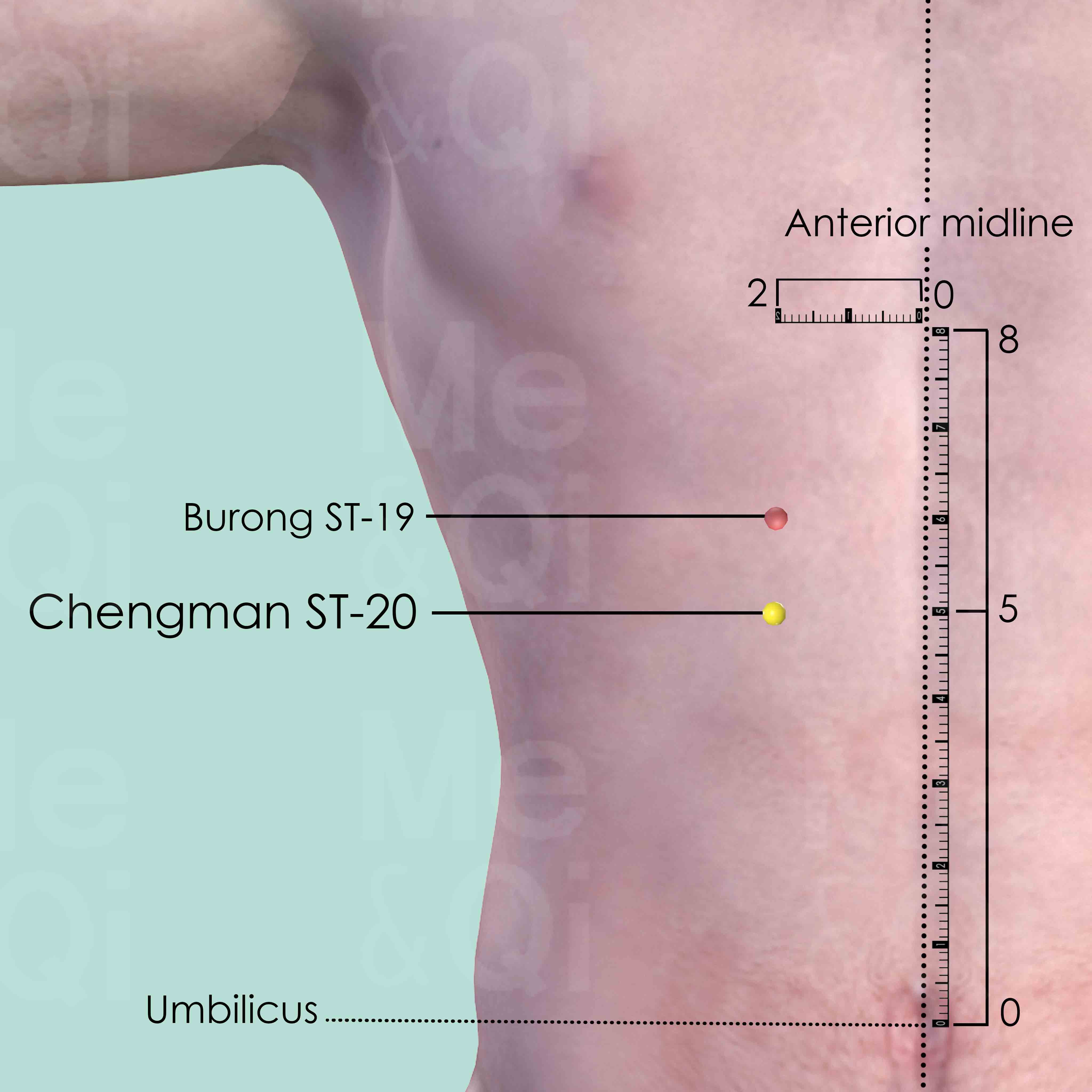
Chengman ST-20
5 cun above the umbilicus and 2 cun lateral to the anterior midline, or 1 cun below Burong ST-19.
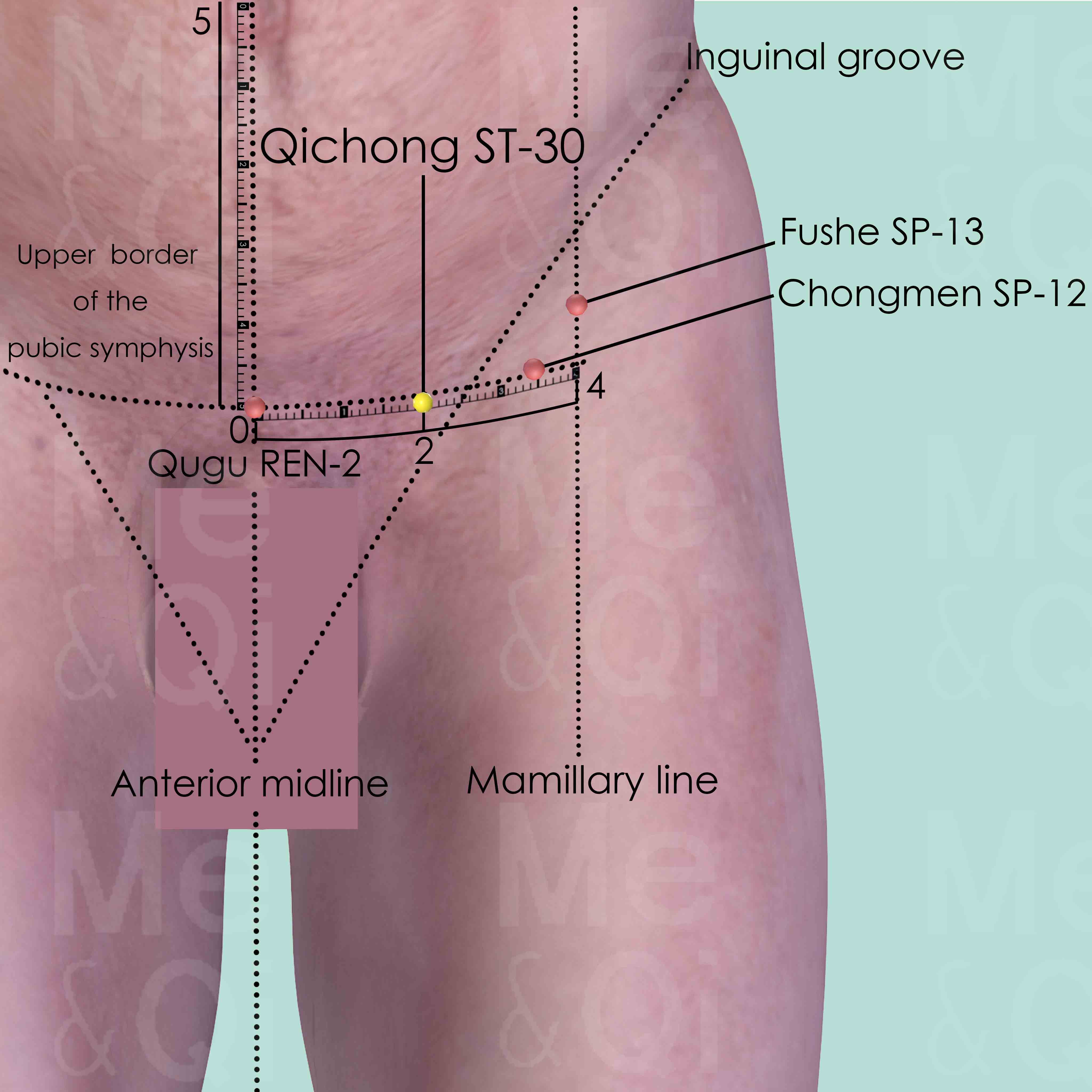
Qichong ST-30
5 cun below the umbilicus, 2 cun lateral to the anterior midline, superior to the inguinal groove, on the medial side of the femoral artery, nerve and vein.
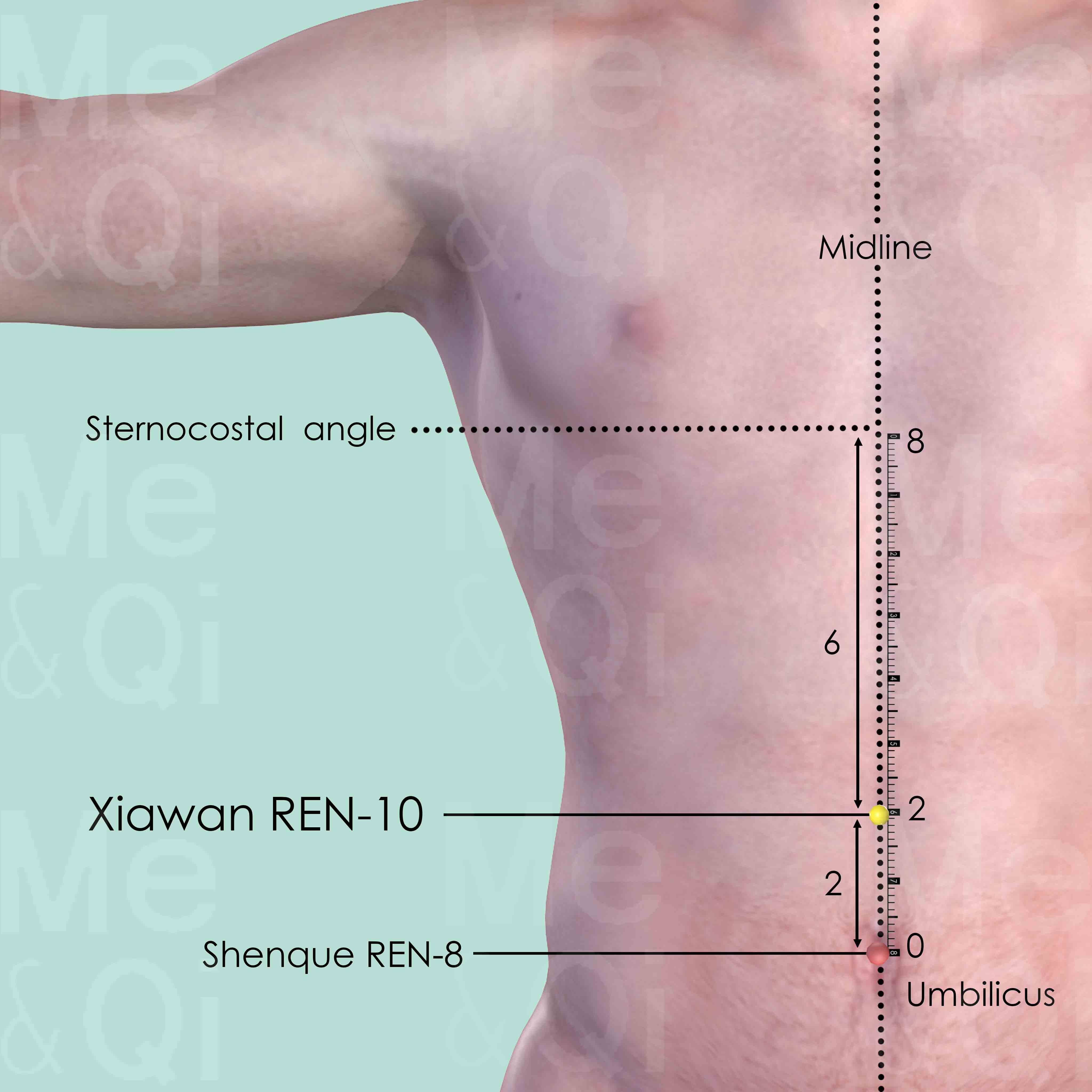
Xiawan REN-10
On the midline of the abdomen, 2 cun above the umbilicus and 6 cun below the sternocostal angle.
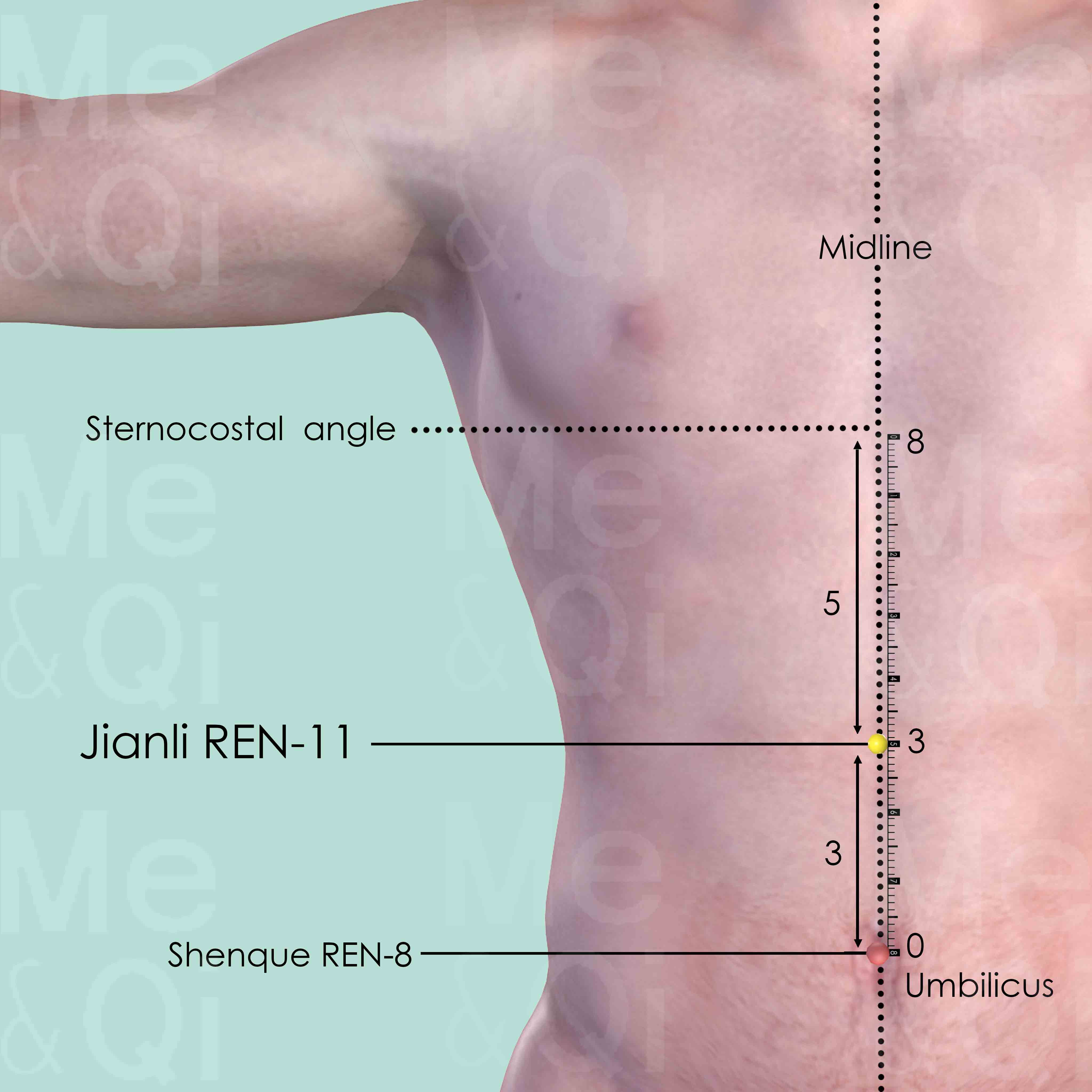
Jianli REN-11
On the midline of the abdomen, 3 cun above the umbilicus and 5 cun below the sternocostal angle.
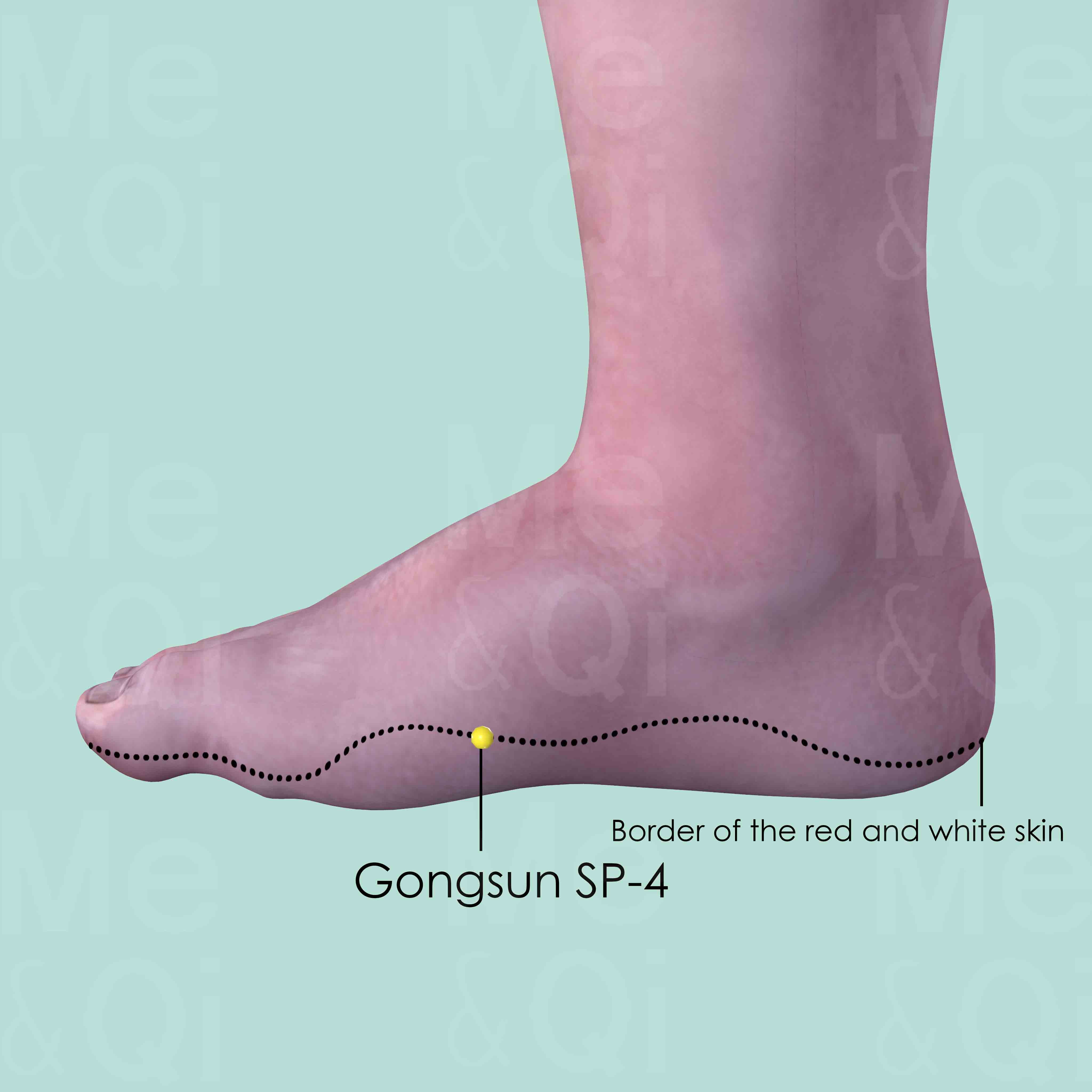
Gongsun SP-4
In the depression distal and inferior to the base of the 1st metatarsal bone, at the border of the red and white skin.
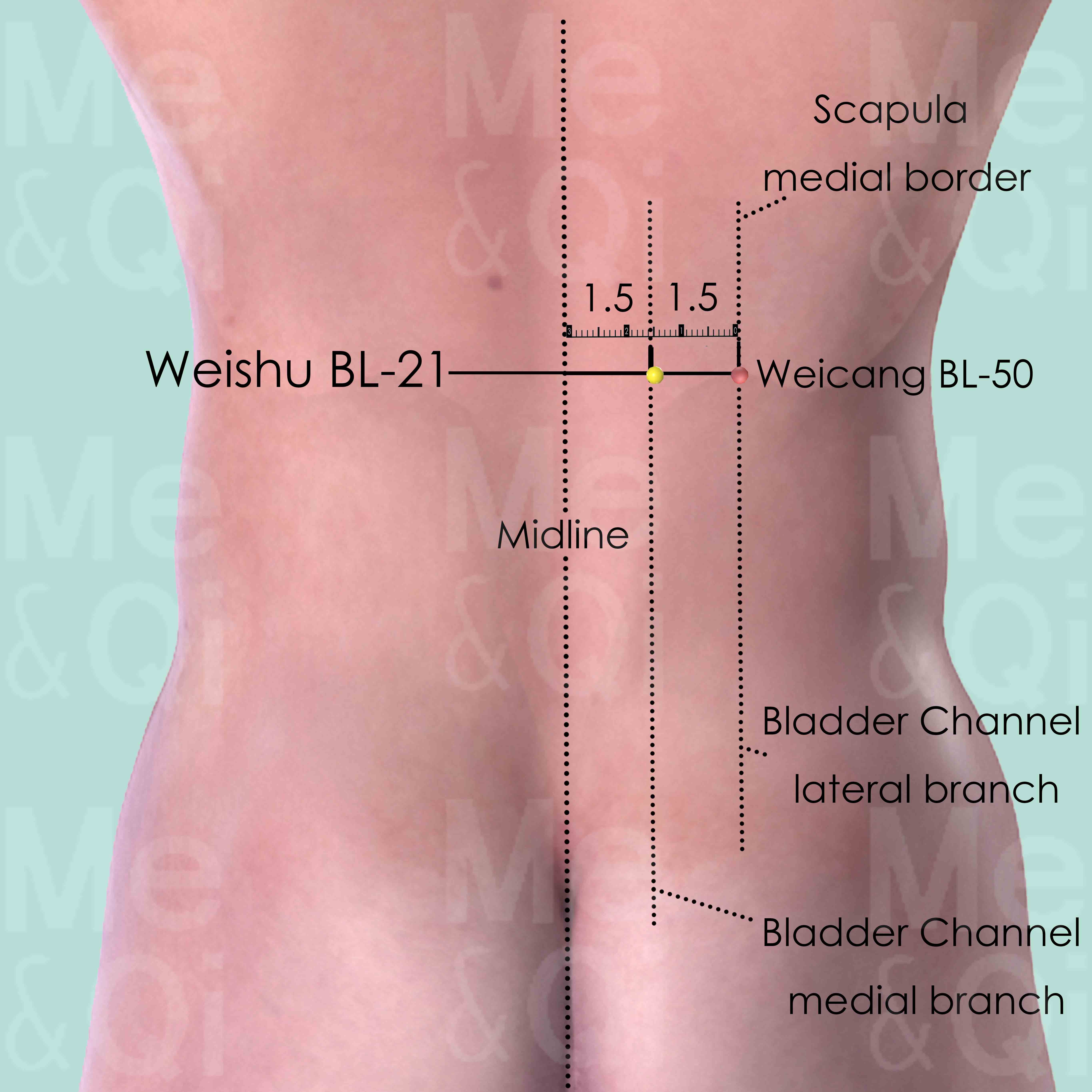
Weishu BL-21
1.5 cun lateral to the lower border of the spinous process of the 12th thoracic vertebra (T12).
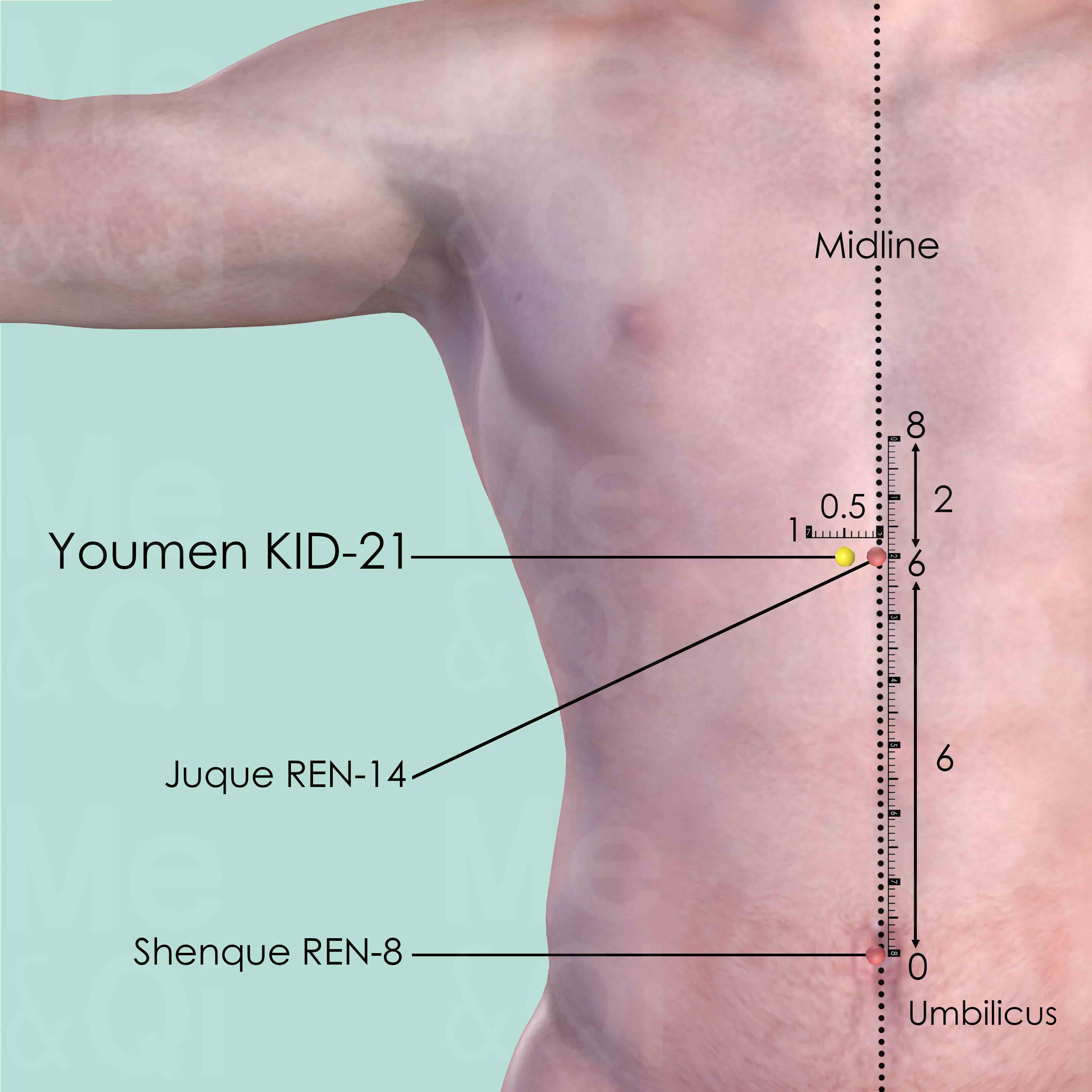
Youmen KID-21
6 cun above the umbilicus and 2 cun below the sternocostal angle, 0.5 cun lateral to the anterior midline.
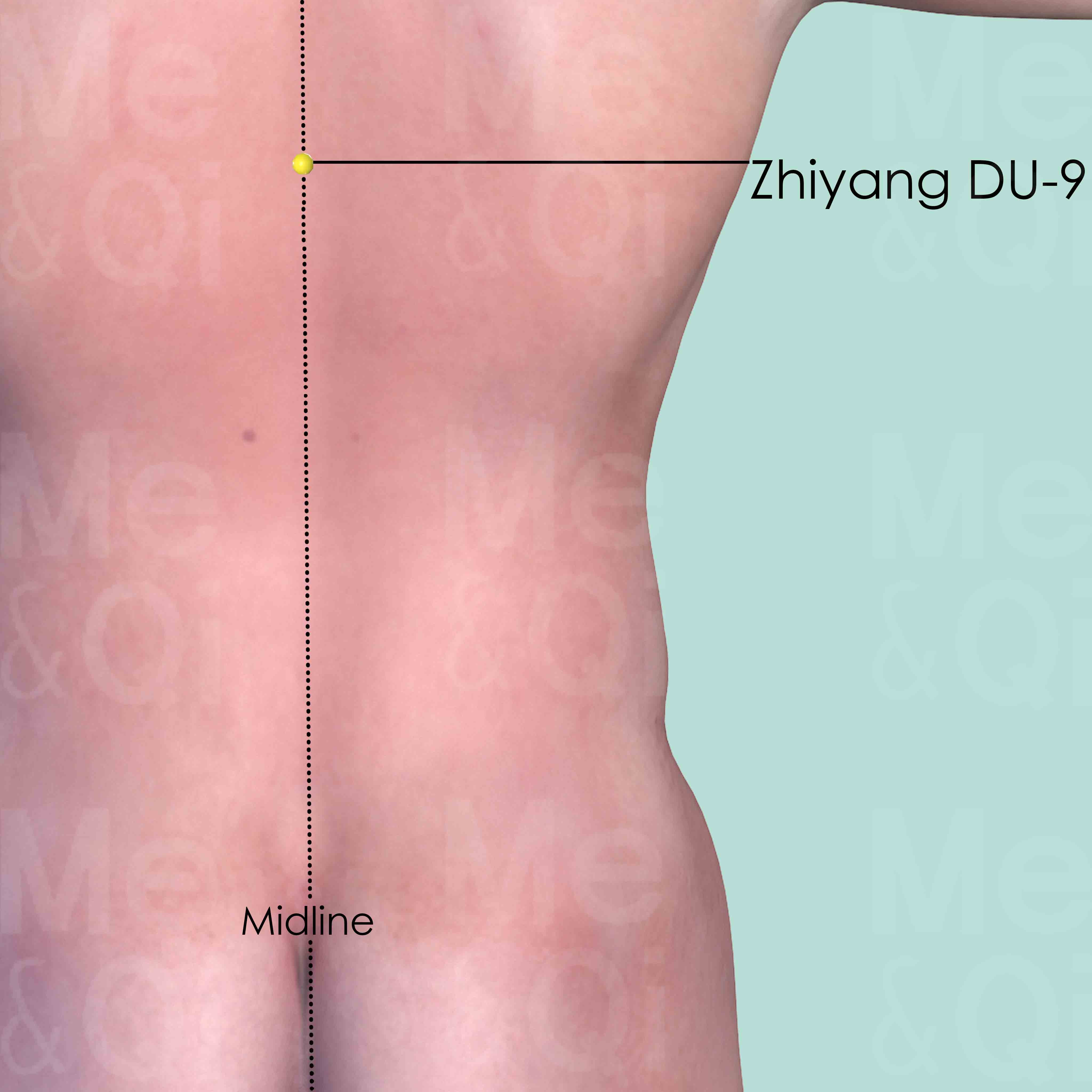
Zhiyang DU-9
On the back midline, in the depression below the spinous process of the 7th thoracic vertebra (T7).
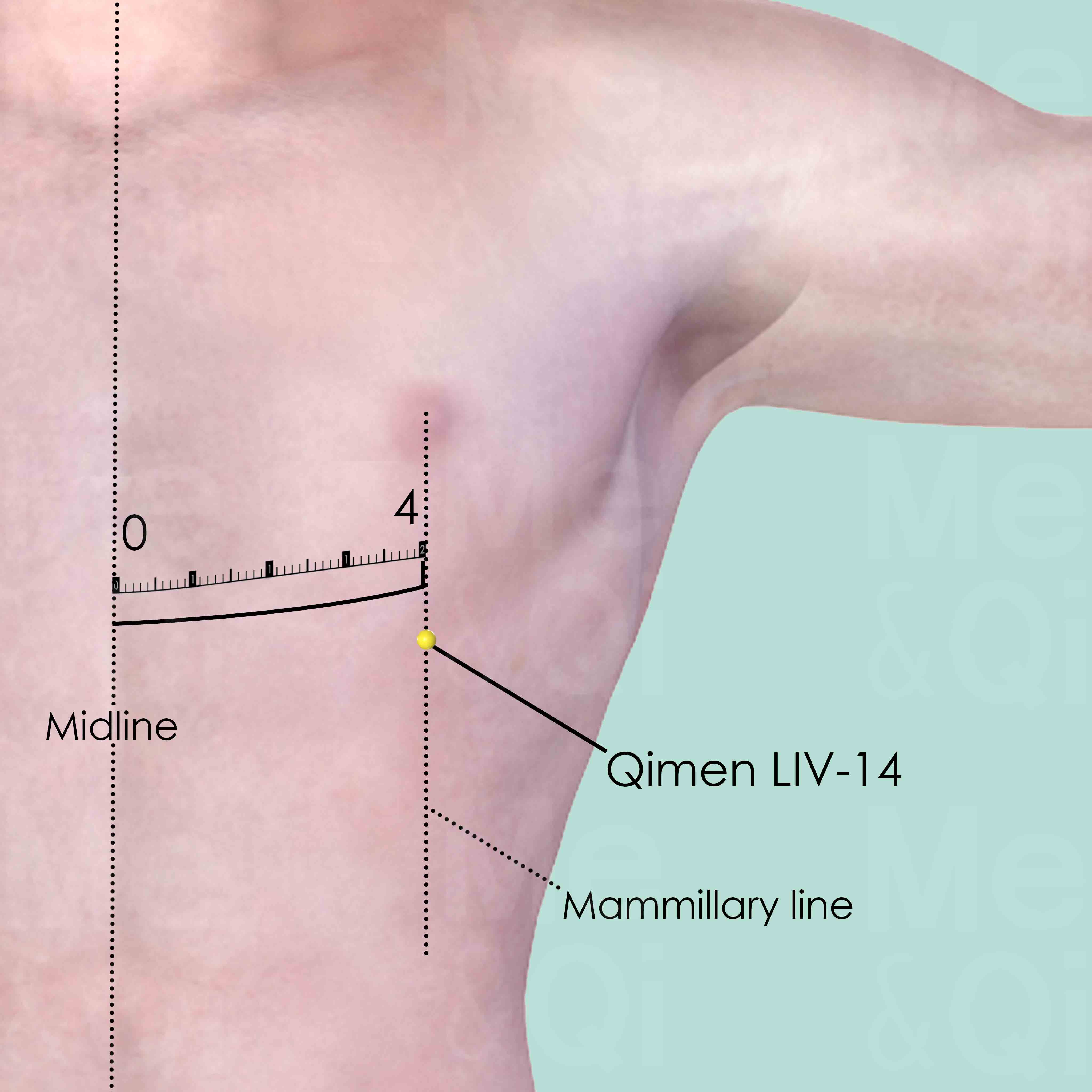
Qimen LIV-14
On the mammillary line, two ribs below the nipple, in the 6th intercostal space, 4 cun lateral to the midline. Please note that there is an alternative location for LIV-14 at the lower edge of the ribcage in line with the nipple or, in women, 4 cun from the midline. In fact, one could look upon these as two separate points. The one in the intercostal space is used more for Channel problems. While the one at the lower edge of the ribcage is used more for Organ problems.

